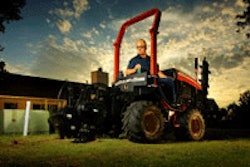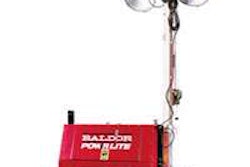PITTSBURGH (Aug. 10, 2009) After years of continual use and limited attention to structural repairs, the mid-century bridge supporting Noblestown Road, a vital state highway for commuters in and around Pittsburgh, desperately needed repair. Rather than only focusing on cosmetic surface treatments, as was the case in a number of past repairs, the Pennsylvania Department of Transportation (PennDOT) decided it was time to fully rehabilitate the bridge and its piers by removing all unsound, deteriorated concrete and filling in any voids with shotcrete. Given the structure’s poor condition and a strict completion deadline, the rehabilitation required effective communication and cooperation between the general contractor, subcontractors and material suppliers to complete the necessary repairs. The $960,000 rehabilitation project, which took place from July to November 2008, involved concrete repairs to the substructure, concrete piers and deck and expansion joints.
The QUIKRETE completed by general contractor West Sunbury, Penn.-based Thornbury Inc. and shotcrete contractor Clinton, Penn.-based The Sofis Company using QUIKRETE pre-blended with a migrating corrosion inhibitor. “This project had a number of factors that made it more difficult than a lot of other projects that are similar in nature,” said Dennis Bittner, QUIKRETE representative. “Crews had to rehabilitate this extremely well-used and active bridge on a tight deadline while taking the bridge’s structural integrity into account.”
Due to structural concerns, crews could not remove concrete from both sides of the piers’ hammerheads at the same time. Instead, crews had to work on one side at a time before moving to the other side.
“We had to make the saw cuts, remove the concrete, sandblast the reinforcing bars, install the mesh and dowels, and then complete the shotcrete, before we could move to the other side of the pier,” said Ted Sofis of The Sofis Company. “On most projects, you can do all the removal and follow with the other tasks so each operation is working continuously which is more efficient. At each pier, we could only work on one side at a time, so with two piers at each location that required four operations.”
Because the road is such a busy thoroughfare, only half the bridge could be closed at any given time to accommodate the work. Therefore, all eastbound traffic was diverted to the two westbound lanes and vice versa as crews worked on the structure below the roadway. Once traffic was rerouted – and the weight of the cars was removed from the deck – crews erected towers to support the bridge. That helped further alleviate the weight of the bridge deck and allowed crews to more easily – and more safely – remove the crumbling concrete from the bridge’s deck, substructure and piers.
More Than Cosmetic Work
In the past, the majority of work completed on the bridge was cosmetic in nature and had little structural value. But for this particular rehabilitation, the shotcrete contractor added new reinforcing bars where needed, installed mesh, drilled and installed epoxy anchor bars and concluded by placing shotcrete to restore the rounded concrete piers to their original contours.
“It’s always better when you get behind the reinforcing bars because it ties the structure together,” Sofis said. “Shotcrete allows you place material in places that are difficult to access, and it gives you the ability to place material overhead or on vertical surfaces without forming,” Sofis said. “Shotcrete saves a lot of time and labor, and it provides a cost effective alternative to conventional concrete placement.”
While the shotcrete repair was being completed, the general contractor also was responsible for areas requiring Class AA concrete repairs.
This required work to be coordinated between both the general contractor and shotcrete contractor to properly sequence the repair work. In addition, crews had to finish the project by November. After November, the weather would be too cold for crews to reasonably work outdoors without taking more extreme measures to keep the worksite from freezing.
Advantages of Shotcrete
A total of 116 3,000-pound bags of QUIKRETE migrating corrosion inhibitor were used in conjunction with a silo system.
QUIKRETE sand specially designed for repairing above- or below-grade concrete and mortar. QUIKRETE
® Shotcrete MS pre-blended with a® Shotcrete MS is a well-proportioned blend of Portland cement and concrete® Shotcrete MS is a one-component dry process shotcreting material containing micro silica that was designed for high strength, improved sulphate resistance, high adhesion, low permeability, low rebound and low sag.
“QUIKRETE Road bridge repair,” Bittner said. “Crews used a material that was well-suited for their needs and let them finish work as quick as possible. This bridge repair is one that will last for many years to come and will help ensure that commuters travel safely in and around Pittsburgh.”
® Shotcrete MS is the perfect solution for a project like the Noblestown The QUIKRETE® Companies
The QUIKRETE mixes in the United States and Canada, and an innovative leader in the commercial building and home improvement industries. QUIKRETE 90 manufacturing facilities in the United States, Canada, Puerto Rico and South America, allowing for unsurpassed distribution and product depth. The QUIKRETE ensures that professionals and consumers alike are provided with the most innovative and highest quality products available on the market. For additional information on The QUIKRETE
® Companies is the largest manufacturer of packaged concrete and cement® products are manufactured and bagged in® Technical Center®
Companies or its products, please visit
www.quikrete.com or call (800) 282-5828.
www.quikrete.com or call (800) 282-5828.
A Tricky Sequence of Events
A Tricky Sequence of Events
Due to structural concerns, crews could not remove concrete from both sides of the piers’ hammerheads at the same time. Instead, crews had to work on one side at a time before moving to the other side.
“We had to make the saw cuts, remove the concrete, sandblast the reinforcing bars, install the mesh and dowels, and then complete the shotcrete, before we could move to the other side of the pier,” said Ted Sofis of The Sofis Company. “On most projects, you can do all the removal and follow with the other tasks so each operation is working continuously which is more efficient. At each pier, we could only work on one side at a time, so with two piers at each location that required four operations.”
Because the road is such a busy thoroughfare, only half the bridge could be closed at any given time to accommodate the work. Therefore, all eastbound traffic was diverted to the two westbound lanes and vice versa as crews worked on the structure below the roadway. Once traffic was rerouted – and the weight of the cars was removed from the deck – crews erected towers to support the bridge. That helped further alleviate the weight of the bridge deck and allowed crews to more easily – and more safely – remove the crumbling concrete from the bridge’s deck, substructure and piers.
More Than Cosmetic Work
In the past, the majority of work completed on the bridge was cosmetic in nature and had little structural value. But for this particular rehabilitation, the shotcrete contractor added new reinforcing bars where needed, installed mesh, drilled and installed epoxy anchor bars and concluded by placing shotcrete to restore the rounded concrete piers to their original contours.
“It’s always better when you get behind the reinforcing bars because it ties the structure together,” Sofis said. “Shotcrete allows you place material in places that are difficult to access, and it gives you the ability to place material overhead or on vertical surfaces without forming,” Sofis said. “Shotcrete saves a lot of time and labor, and it provides a cost effective alternative to conventional concrete placement.”
While the shotcrete repair was being completed, the general contractor also was responsible for areas requiring Class AA concrete repairs.
This required work to be coordinated between both the general contractor and shotcrete contractor to properly sequence the repair work. In addition, crews had to finish the project by November. After November, the weather would be too cold for crews to reasonably work outdoors without taking more extreme measures to keep the worksite from freezing.
Advantages of Shotcrete
A total of 116 3,000-pound bags of QUIKRETE migrating corrosion inhibitor were used in conjunction with a silo system.
QUIKRETE sand specially designed for repairing above- or below-grade concrete and mortar. QUIKRETE
® Shotcrete MS pre-blended with a® Shotcrete MS is a well-proportioned blend of Portland cement and concrete® Shotcrete MS is a one-component dry process shotcreting material containing micro silica that was designed for high strength, improved sulphate resistance, high adhesion, low permeability, low rebound and low sag.
“QUIKRETE Road bridge repair,” Bittner said. “Crews used a material that was well-suited for their needs and let them finish work as quick as possible. This bridge repair is one that will last for many years to come and will help ensure that commuters travel safely in and around Pittsburgh.”
® Shotcrete MS is the perfect solution for a project like the Noblestown The QUIKRETE® Companies
The QUIKRETE mixes in the United States and Canada, and an innovative leader in the commercial building and home improvement industries. QUIKRETE 90 manufacturing facilities in the United States, Canada, Puerto Rico and South America, allowing for unsurpassed distribution and product depth. The QUIKRETE ensures that professionals and consumers alike are provided with the most innovative and highest quality products available on the market. For additional information on The QUIKRETE
® Companies is the largest manufacturer of packaged concrete and cement® products are manufactured and bagged in® Technical Center®
Companies or its products, please visit
www.quikrete.com or call (800) 282-5828.
www.quikrete.com or call (800) 282-5828.







